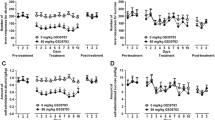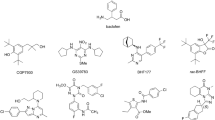Abstract
Recently, the GABAB receptor antagonist phaclofen has been shown to attenuate the stimulation of locomotor activity induced by ethanol (Allan and Harris 1989). In the present study, the effects of a range of recently developed GABAB receptor antagonists (phaclofen, 2-hydroxysaclofen, beta-phenyl-beta-alanine, CGP 35348) and the GABAB receptor agonist baclofen, were studied for their ability to block the locomotor stimulation induced by a low dose of ethanol administered IP to mice (1.75 g/kg). Results showed that phaclofen, 2-hydroxysaclofen, BPBA and baclofen all dose-dependently decreased ethanol-induced locomotor activity, and, of these, baclofen and BPBA did so at doses which did not attenuate locomotor activity when administered alone. CGP 35348 had no effect on the activity produced by ethanol. The action of baclofen on ethanol-induced activity appeared to be GABAB receptor mediated, as the effects were stereospecific and were reversed by the antagonist, CGP 35348. However phaclofen, 2-hydroxysaclofen and BPBA failed to reverse the effects of baclofen. These results suggest that the GABAB receptor may modulate locomotor stimulation induced by low doses of ethanol, and furthermore, that agonist, rather than antagonist activity at the GABAB receptor is responsible for this reduction. The GABAB receptor subtype responsible for modulating the effects of ethanol may have properties different from those GABAB receptors characterised to date.
Similar content being viewed by others
References
Alford S, Christenson J, Grillner S (1990) Presynaptic GABAA and GABAB receptor mediated phasic modulation in axons of spinal motor interneurons. Eur J Neurosci 3:107–117
Allan AM, Harris RA (1989) A new alcohol antagonist: phaclofen. Life Sci 45:1771–1779
Aran S, Hammond DL (1991) Antagonism of baclofen-induced antinociception by intrathecal administration of phaclofen or 2-hydroxy-saclofen, but not gamma-aminovaleric acid in the rat. J Pharmacol Exp Ther 257:360–368
Becker HC (1988) Effects of the imidazobenzodiazepine RO15-4513 on the stimulant and depressant actions of ethanol on spontaneous locomotor activity. Life Sci 43:643–650
Becker HC, Hale RL (1989) Ethanol-induced locomotor stimulation in C57BL/6 mice following RO15-4513. Psychopharmacology 99:333–336
Bittiger H, Froestl W, Hall R, Karlsson G, Klebs K, Olpe HR, Pozza MF, Steinman MW, Van Riezen H (1990) Biochemistry, electrophysiology and pharmacology of a new GABAB antagonist: CGP 35348. In: Bowery NG, Bittiger H, Olpe HR (eds) GABAB receptors in mammalian function. Wiley, NY, pp 47–60
Bowery NG (1989) GABAB receptors and their significance in mammalian pharmacology. TIPS 10:401–407
Cott J, Carlsson A, Engel J, Lindqvist M (1976) Suppression of ethanol-induced locomotor stimulation by GABA-like drugs. Naunyn-Schmiedeberg's Arch Pharmacol 295:203–209
Crabbe JC, Johnson NA, Gray DK, Kosobud A, Young ER (1982) Biphasic effects of ethanol on open-field activity in C57BL/6N and DBA/2N mice. J Comp Physiol Psychol 96:440–451
Drew CA, Johnston GAR, Kerr DIB, Ong J (1990) Inhibition of baclofen binding to rat cerebellar membranes by phaclofen, saclofen, 3-aminopropylphosphonic acid and related GABAB receptor antagonists. Neurosci Lett 113:107–110
Dunnett CW (1955) A multiple comparison procedure for comparing several treatments with a control. J Am Statist Assoc 50:1096–1121
Dutar P, Nicoll RA (1988) Pre and postsynaptic GABAB receptors in the hippocampus have different pharmacological properties. Neuron 1:585–598
Fromm GH, Shibuya T, Nakata M, Terrence CF (1990) Effects of d-baclofen and l-baclofen on the trigeminal nucleus. Neuropharmacology 29:249–254
Frye GD, Taylor L, Trzeciakowski JP, Griffith WH (1991) Effects of acute and chronic ethanol treatment on pre- and postsynaptic responses to baclofen in rat hippocampus. Brain Res 560:84–91
Fuxe K, Hokfelt T, Ljungdahl A, Agnati L, Johansson O, Perez de la Mora M (1975) Evidence for an inhibitory gabaergic control of the meso-limbic dopamine neurons: possibility of improving treatment of schizophrenia by combined treatment with neuroleptics and gabaergic drugs. Med Biol 53:177–183
Gerald DF, Breese GR (1981) An evaluation of the locomotor stimulating action of ethanol in rats and mice. Psychopharmacology 75:372–379
Gordon ER (1967) The effect of ethanol on the concentration of gamma-aminobutyric acid in the rat brain. Can J Physiol Pharmacol 45:915–918
Gray JA, Goodwin GM, Heal DJ, Green AR (1987) Hypothermia induced by baclofen, a possible index of GABAB receptor function in mice, is enhanced by antidepressant drugs and ECS. Br J Pharmacol 92:863–870
Hahner L, McQuilkin S, Harris RA (1991) Cerebellar GABAB receptors modulate function of GABAA receptors. FASEB J 5:2466–2472
Hara N, Hara Y, Goto Y (1990a) Effects of GABA antagonists and stuctural GABA analogues on baclofen stimulated gastric acid secretion in the rat. Jpn J Pharmacol 52:345–352
Hara N, Natsume Y, Hara Y, Goto Y (1990b) Gastric acid inhibitory action of a GABA-related compound, 3-amino-3-phenylpropionic acid, in the rat. Eur J Pharmacol 179:17–23
Harrison NL, Lovinger DM, Lambert NA, Teyler TJ, Prager RH, Ong J, Kerr DIB (1990) The actions of 2-hydroxy-saclofen at presynaptic GABAB receptors in the rat hippocampus. Neurosci Lett 119:272–276
Hill DR, Bowery NG (1981)3H-baclofen and3H-GABA bind to bicuculline-insensitive GABAB sites in rat brain. Nature 290:149–152
Imperato A, Di Chiara G (1986) Preferential stimulation of dopamine release in the nucleus accumbens of freely moving rats by ethanol. J Pharmacol Exp Ther 239:219–228
Jackson HC, Nutt DJ (1991) Inhibition of baclofen-induced hypothermia in mice by the novel GABAB antagonist CGP 35348. Neuropharmacology 30:535–538
Kaneko T, Hicks TP (1988) Baclofen and gamma-aminobutyric acid differentially suppress the cutaneous responsiveness of primary somatosensory cortical neurons. Brain Res 443:360–366
Kerr DIB, Ong J, Johnston GAR, Abbenante J, Prager RH (1988) 2-Hydroxy-saclofen: an improved antagonist at central and peripheral GABAB receptors. Neurosci Lett 92:92–96
Kerr DIB, Ong J, Johnston GAR, Abbenante J, Prager RH (1989) Antagonism at GABAB receptors by saclofen and related sulphonic analogues of baclofen and GABA. Neurosci Lett 107:239–244
Kerr DIB, Ong J, Prager RH, Gynther BD, Curtis DR (1987) Phaclofen: a peripheral and central baclofen antagonist. Brain Res 405:150–154
Liljequist S, Engel J (1982) Effects of GABAergic agonists and antagonists on various ethanol-induced behavioural changes. Psychopharmacology 78:71–75
Martz A, Dietrich RA, Harris RA (1983) Behavioural evidence for the involvement of gamma-aminobutyric-acid in the actions of ethanol. Eur J Pharmacol 89:53–62
Matheson GK, Freed E, Tunnicliff G (1987) Central receptor binding and cardiovascular effects of GABA analogues in the cat. Gen Pharmacol 18:269–273
Mehta AK, Ticku MK (1990) Are GABAB receptors involved in the pharmacological effects of ethanol? Eur J Pharmacol 182:473–480
Morishta R, Kato K, Asano T (1990) GABAB receptors couple to G proteins Go, G*o, and Gi1 but not to Gi2. FEBS Lett 271:231–235
Ogata N (1987) Gamma-aminobutyric acid (GABA) causes consistent depolarization of neurons in the guinea pig supraoptic nucleus due to an absence of GABAB recognition sites. Brain Res 403:225–233
Olpe HR, Karlsson G, Pozza MF, Brugger F, Steinmann M, Van Riezen H, Fagg G, Hall RG, Froestl W, Bittiger H (1990) CGP 35348: a centrally active blocker of GABAB receptors. Eur J Pharmacol 187:27–38
Ong J, Kerr DIB, Abbenante J, Prager RH (1991) Short-chain baclofen analogues are GABAB-receptor antagonists in the guinea-pig ileum. Eur J Pharmacol 205:319–322
Paredes R, Agmo A (1989) Stereospecific actions of baclofen on sociosexual behaviour, locomotor activity and motor execution. Psychopharmacology 97:358–364
Pohorecky LA (1977) Biphasic action of ethanol. Biobehav Rev 1:231–240
Randall AD, Schofield JG, Davies CH, Collingridge GL (1990) The baclofen depression of excitatory synaptic transmission in rat hippocampus in vitro can be reversed by 2-hydroxy-saclofen. J Physiol 426:51P
Sekiguchi M, Sakuta H, Okamoto K, Sakai Y (1990) GABAB receptors expressed inXenopus oocytes by guinea pig cerebral mRNA are functionally coupled with Ca2+-dependent Cl− channels and with K+ channels, through GTP-binding proteins. Mol Brain Res 8:301–309
Stirling JM, Cross AJ, Robinson TN, Green AR (1989) The effects of GABAB receptor agonists and antagonists on potassium-stimulated [Ca2+]i in rat brain synaptosomes. Neuropharmacology 28:699–704
Stuart GJ, Redman SJ (1992) The role of GABAA and GABAB receptors in presynaptic inhibition of Ia EPSPs in cat spinal motorneurons. J Physiol 447:675–692
Ticku MK, Lowrimore P, Lehoullier P (1986) Ethanol enhances GABA-induced Cl-flux in primary spinal cord cultured neurons. Brain Res Bull 17:123–126
Wilkin GP, Hudson AL, Hill DR, Bowery NG (1981) Autoradiographic localization of GABAB receptors in rat cerebellum. Nature 294:584–587
Author information
Authors and Affiliations
Rights and permissions
About this article
Cite this article
Humeniuk, R.E., White, J.M. & Ong, J. The role of GABAB receptors in mediating the stimulatory effects of ethanol in mice. Psychopharmacology 111, 219–224 (1993). https://doi.org/10.1007/BF02245527
Received:
Revised:
Issue Date:
DOI: https://doi.org/10.1007/BF02245527




